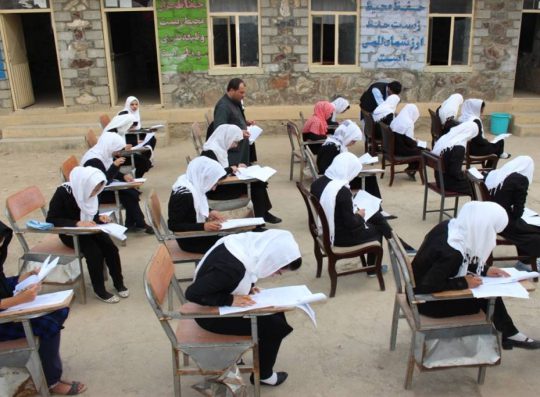THE CHALLENGE
Though significant progress has been achieved in education since the fall of the Taliban with the number of students increasing from 1 million (consisting largely of boys) in 2001 to 9 million in 2016 (of which girls only represent 39%), education in Afghanistan remains insecure. Today, 3.7 million Afghan children are still not educated, that equates to nearly half of all children, aged 7 to 17 years old. Of this, 85 percent come from rural areas and 60 percent are girls.
Many factors contribute to hindering girls from attending school, such as the lack of infrastructure, remoteness of schools in rural areas and the insecurity of the journey to go to school. The shortage of teachers, particularly female teachers (only 30 percent of teachers are women), is also a major obstacle as is insufficient qualifications (only 24 percent of teachers meet the minimum qualifications). High school girls are most at risk of dropping out. Many families refuse to allow their daughters to attend classes taught by male teachers.
There is also another phenomenon in Afghanistan called Bacha posh, which is literally translated as “dressed like a boy”. Bacha posh remains a reality until today. In this very conservative country, some girls are forced to drop out of school and disguise themselves as boys in order to provide for their families.
In total, almost one-third of Afghan children are left behind, among them 75 percent are girls.
The SOLUTIONS WE'RE PROPOSING
In response to this issue, W4’s field partner Afghanistan Libre has established a program called PAGE (Promotion of Afghan Girls Education) in 7 rural public schools in the Paghman district and the Panjshir province. PAGE consists of different projects, all of which are committed to promoting girls’ education until higher education and preparing them for the professional world.
- Preparation for Kankor (the university entrance exam): Students are provided tutoring in science courses which hold the most weight in the exam as well as transportation to the exam location, enabling them to perform well in the exam and have a better chance at accessing university education.
- Teacher’s training and self-learning: There are still not enough qualified female teachers. We have therefore developed a program to train them, under the instruction of professors from Kabul, as well as a self-training system (in the form of digital supports to allow the teachers to continue the training on their own).
- Digital classrooms: The Afghan labor market is increasingly becoming more digital, so this year we have introduced computer-assisted IT and English courses for high school students. Eventually, we would like to integrate as well courses in coding.
At the same time, this program also provides support on an ad hoc basis helping to: build and plan classes, provide school supplies and equipment, install solar panels, and set up libraries.
THE IMPACT OF GIVING
Thanks to your generosity, we will be able to maintain and develop this girls’ education program which aims to create educational opportunities for girls who would otherwise be deprived access to education, especially at university level, and to the job market. Our intention, through this program, is to enable roughly 1,000 students to benefit from quality education.
By supporting the training of female teachers, you encourage the education of high school students who are sometimes prevented by their families from attending classes taught by male teachers.
You are also supporting the girls’ preparation for the Kankor, which will allow them to have a real chance to pursue higher education and become active agents of their own futures. Nearly 200 students each year could benefit from this program.
Finally, your giving would also enable us to develop digital classes, allowing students to obtain the necessary IT skills to access the Afghan labor market.
Education is a barrier against ignorance and is key to progress. When girls are educated, they empower themselves and acquire the capacity to participate actively in the political, economic, and social development of their country. We need your support to make this a reality!
WHAT YOUR DONATION FUNDS
Your donations are eligible for a tax deduction of 66% of the amount of the donation. So, after tax deduction, a donation of 100 euros becomes 33 euros.
70€ (23€ after tax deduction) = Training of 1 teacher
90€ (30€ after tax deduction) = Kankor preparation for 1 student
240€ (80€ after tax deduction) = 1 computer for the digital classrooms
800€ (264€ after tax deduction) = 1 solar panel to compensate for the lack of electricity

















